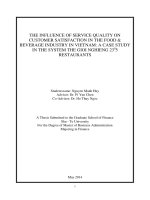assessing a customer service model in the financial services industry
Bạn đang xem bản rút gọn của tài liệu. Xem và tải ngay bản đầy đủ của tài liệu tại đây (900.21 KB, 241 trang )
ASSESSING A CUSTOMER SERVICE MODEL IN THE FINANCIAL SERVICES
INDUSTRY: A PHENOMENOLOGICAL STUDY
by
William Darren Hubbell
A Dissertation Presented in Partial Fulfillment
of the Requirements for the Degree
Doctor of Management in Organizational Leadership
UNIVERSITY OF PHOENIX
October 2007
UMI Number: 3302618
3302618
2008
Copyright 2007 by
Hubbell, William Darren
UMI Microform
Copyright
All rights reserved. This microform edition is protected against
unauthorized copying under Title 17, United States Code.
ProQuest Information and Learning Company
300 North Zeeb Road
P.O. Box 1346
Ann Arbor, MI 48106-1346
All rights reserved.
by ProQuest Information and Learning Company.
© 2007 by William Darren Hubbell
ALL RIGHTS RESERVED
Assessing a Customer Service Model in the Financial Services Industry: A
Phenomenological Study.
by
William Darren Hubbell
November
2007
Approved:
MEEDrm
WARD,
ED.
D., Mentor
TIMOTHY THOMAS CROWNER, Ph. D., Committee Member
NANCY
KYMN
RUTIGLIANO, Ph. D., Committee Member
Accepted and Signe
Accepted and Signe
Dean,
School
of
Advanced Studies
University
of
Phoenix
ABSTRACT
The qualitative, phenomenological study examines the perspective of debt collection
professionals at XYZ Financial Services to acquire an in-depth understanding of the
Three Cs model, a customer relations model relevant to the financial services industry.
Findings presented how the model has supported debt collection efforts, improved
customer relations, and provided a positive image for the financial services industry. The
process whereby deploying the Three Cs model in an attempt to transform XYZ Financial
Services into a culture of value was based on the themes that emerged within four
dimensions. Internal process involves monitoring and assuring collectors are following
state and federal guidelines that govern debt collection. Human relation involves the
skill-sets needed to be a successful collector and the free flow of information between
collectors and departments. Open system involves adaptation to external forces, which
would include complying with guidelines governing debt collection and adaptation to
changing customer characteristics (smart debtor). Rational goal involves using the Three
Cs to cope with external forces. Findings show the model has been implemented
throughout the collection department.
v
DEDICATION
This study is dedicated to my grandfather, William F. Kellogg, who died many years ago,
but passed his own work ethic, passion, and entrepreneurial spirit to his oldest grandson.
This study is also dedicated to my grandmother, Katheryn Kellogg and my mother, Marie
Elena Kellogg-Hubbell, for their unconditional love and dedication throughout my life.
vi
ACKNOWLEDGMENTS
I would like to give special thanks to my family, especially my wife, Wendy, for her
patience, support, and understanding throughout the doctoral journey. Also, my children,
Rudy, Ashley, Amanda, Steven and David James (D.J.), for their understanding that Dad
needed to do a lot of homework, and could not do some things with them. There will be a
lot of making up over the next few years. I would also like to acknowledge my father,
George Kawa’a Hubbell III for the fire he instilled in me growing up and the attitude and
intensity he demanded. Also, I would like to acknowledge my brother, Steven, for being
my best friend. Special acknowledgement goes to Mr. B. E. Newmark, a professional
colleague, who sparked the idea for the Three C model that drove this study.
Additionally, I would like to acknowledge the training team at XYZ Financial Services:
Bill Shirley III, Micaela Salcido, Brenda Moreno, and Shirley Legaspi, and the Human
Resource team, Ken Lozano and Jennifer Armstrong. Without their passion for
excellence, the Three C initiative would never have been implemented and this study
never concluded. Special acknowledgements go to my mentor, Dr. Meredith Ward,
committee members, Dr. Tim Crowner and Dr. Kymn Harvin Rutigliano, and analyst and
editor, Dr. Brenda Nelson-Porter. Further acknowledgements go to Herb Kay, Anthony
Miceli, Alvin Gonzalez, Gary Ahu, Matt Roberts, Nick Manfredi, Mark McClarie and
Misa Alexander. Without the guidance and support of my professional and personal
colleagues over the years, the doctoral journey never would have been possible.
vii
TABLE OF CONTENTS
LIST OF TABLES xii
LIST OF FIGURES xiii
CHAPTER 1: INTRODUCTION 1
Background 2
Problem Statement 10
Purpose of the Study 11
Significance of the Study 12
Significance of the Study Contributions 12
Significance of the Study to the Field of Leadership 13
Nature of the Study 14
Research Questions 15
Conceptual Framework 16
Hiring 18
Training 18
Customer Relations 19
Supervision and Leadership 20
Quality Assurance 21
Definition of Terms 22
Assumptions 24
Scope 25
Limitations of the Scope 26
Delimitations of the Scope 27
viii
Summary 27
CHAPTER 2: REVIEW OF THE LITERATURE 30
Titles Searches, Articles, Research Documents, Journals Researched 31
Historical Overview 31
Debt Collection Law: Fair Debt Collection Practices Act and the Fair Trade
Commission 33
False and Misleading Representation 36
Unfair Practices 37
Organizational Change 38
Current Findings 44
Hiring 45
Training 47
Customer Relations 51
Supervision and Leadership 57
Quality Assurance 60
Conclusion 62
Summary 62
CHAPTER 3: METHOD 64
Research Methodology 64
Research Method 65
Appropriateness of Design 66
Research Questions 69
Population 71
ix
Sampling 72
Research Ethics 73
Informed Consent 73
Confidentiality 74
Geographic Location 75
Instrumentation 75
Validity 76
Reliability 77
Data Collection 78
Preparation 79
Process 80
Data Analysis 81
Analysis Methodology 81
Transcription of Data 82
Codes and Themes 83
Data Management 84
Validity 84
Internal Validity 85
External Validity 86
Summary 87
CHAPTER 4: RESULTS 88
Participant Selection 88
Pilot Study 89
x
Actual Study 89
The Pilot Process 89
Preparation 90
Pilot Interviews 90
Instrument Reliability 92
Textural Descriptions of Emerging Themes 93
Instrument Validity 106
Conclusion of Pilot Analysis 108
Data Collection of the Actual Study 109
Data Analysis 110
Codes 110
Textural Descriptions of Emerging Themes 116
Member Checking 134
Conclusion 136
Summary 152
CHAPTER 5: CONCLUSIONS AND RECOMMENDATIONS 156
Implications 156
Statement of the Problem 156
Research Method 157
Research Questions 158
Recommendation 160
Senior Officers 161
Managers and Supervisors 164
xi
Collectors and Customer Service Agents 168
Future Research 170
Technical Systems 170
Debt Collection Attorneys 171
Automotive Dealerships 171
Smart Debtors 172
Credit Analysts 173
Conclusions 173
REFERENCES 176
APPENDIX A: QUESTIONNAIRE FOR QUALITATIVE RESEARCH 200
APPENDIX B: INFORMED CONSENT TO USE PREMISE 203
APPENDIX C: INFORMED CONSENT TO PARTICIPATE IN RESEARCH
STUDY 204
APPENDIX D: CONFIDENTIALITY AGREEMENT TRANSCRIPTIONIST 206
APPENDIX E: INTERVIEW SCRIPT 208
APPENDIX F: PILOT STUDY DEMOGRAPHIC 209
APPENDIX G: DATA ANALYST COLLABORATION AGREEENT 211
APPENDIX H: FREQUENCY OF PILOT TEST CODED DATA 212
APPENDIX I: ACTUAL STUDY QUETIONNIARE FOR QUALITATIVE
RESEARCH
216
APPENDIX J: STUDY DEMOGRAPHICS 220
APPENDIX K: FREQUENCY OF STUDY CODED DATA 222
xii
LIST OF TABLES
Table 1 Three Cs Model and Value-Based Leadership 17
Table 2 Overview of Major Literature Title Searches 32
Table 3 Three C Application Model 139
Table 4 Recommended Skill-Set and Knowledge 143
Table 5 Attitudes of Collectors 146
Table 6 Star Performance Transformational Principles 162
Table 7 Quarterly Audit Checklist 166
Table 8 Integrity Evaluation 169
Table F9 Demographics of Pilot Study Participants 209
Table H10 Pilot Test Code 212
Table J11 Demographics 220
Table K12 Coded Data 222
xiii
LIST OF FIGURES
Figure 1. Three Cs model 4
Figure 2. 4Ts model. Transformational Principles for the financial industry. 163
1
CHAPTER 1: INTRODUCTION
The U.S. financial services industry has been placed under scrutiny because of its
inability to effectively address violations of debt collection law, specifically of the Fair
Debt Collection Practices Act (FDCPA) and the Fair Trade Commission Act (FTCA)
(U.S. Federal Trade Commission, 2005). The Three Cs model was created by a financial
service organization to assist management and employees in the debt collection process
and to help reduce exposure to complaints and lawsuits while collecting debt. The U.S.
Fair Trade Commission (2005) reported receiving 345,112 complaints in 2004,
representing a 25% increase from the 275, 434 complaints reported in 2003. The number
of complaints may rise because many individuals encounter some sort of financial crisis,
typically caused by illness, job loss, and poor management of personal income (U.S. Fair
Trade Commission, 2007).
The study evaluated the perceptions and opinions of employees who used the
Three Cs model at XYZ Financial Services (Creswell, 2002). The title XYZ Financial
was used throughout the current study to conceal the actual name of the organization
under study. According to Benham and Francis (2006), a major assertion pertaining to
research ethics is to keep the anonymity of participants.
In the current study, both participants and the financial institution under
investigation remained anonymous. Participants were kept anonymous to protect their
rights. The identity of the financial institution was kept anonymous because participants
may reveal private information, and responses cannot be traced to the organization.
The Three Cs model was created and implemented at XYZ Financial Services to
address the problem of violations of debt collection law. The study assessed whether the
2
employees used the Three Cs model effectively and benefited from the adoption of the
model. In addition, the study determined the applicability of the model for industry
adaptation.
Chapter 1 presents an overview of the legal and personnel issues that have arisen
in debt collection and have resulted in customer complaints and large monetary lawsuits.
Included in the chapter are discussions on the background of the problem, the purpose
and significance of the study, and the nature of the research. Chapter 1 also includes the
research questions, the conceptual framework for the study, the operational definitions of
relevant terms, and the limitations and delimitations of the study.
Background
During the 2004 calendar year, the U.S. Fair Trade Commission (2005) received
over 75,000 customer complaints for third-party collection agencies and in-house
collection departments. Complaints and lawsuits cost millions annually and create a
negative image for the debt collection industry (U.S. Federal Trade Commission, 2005).
Prima facie complaints, such as abusive behavior by collectors, normally begin with a
violation of the FDCPA (U.S. Federal Trade Commission, 2005).
Congress enacted the FDCPA in 1977 because of abusive, harassing, and coercive
tactics used in the business of collecting debt (“Fair Debt Collection,” 1996). The FTCA
governs the activities of in-house collectors who collect debts originating where the loans
or contracts were established (U.S. Federal Trade Commission, 2005). The FDCPA
governs the collection of third-party collectors who collect debts for external companies
that grant loans (“Fair Debt Collection,” 1996).
3
The area of financial services known as sub-prime lending is particularly
vulnerable to consumer complaints and lawsuits because sub-prime lenders have clients
with questionable credit (“Sub-Prime Lending,” 2004). Sub-prime lending serves a
positive function in the financial services industry because it services borrowers who are
unable to secure a loan with traditional lenders. Borrowers are usually first-time buyers
without a qualified co-signer or with past bankruptcies, current delinquent accounts,
automotive repossessions, foreclosures, or a poor Fair Isaac Credit Organization (FICO)
score (“Sub-Prime Lending,” 2004).
A model for leadership training that reduces customer complaints and lawsuits
can alleviate stress within the financial services industry and restore its positive image.
The current study examined the applicability of the Three Cs model to the financial
services industry through exploring its effectiveness with employees of XYZ Financial
Services. In January 2004, a specific model was implemented at XYZ Financial Services,
a full spectrum lender specializing in sub prime lending. The new initiative has been
called the Three Cs, which stands for courtesy, competence, and compliance.
XYZ Financial Services adopted the model after several major debt collection
lawsuits occurred and negatively affected the industry (U.S. Federal Trade Commission,
2005). The Three Cs model was a modification of Wooden’s (2007) pyramid of success,
Rausch and Washbush’s (1998) 3 C model, and Ohmae’s (2006) Strategic Triangle of 3
Cs. The foundational value of the model implemented at XYZ Financial Services has
been that all employees use it in every aspect of their work, including hiring, training,
internal and external customer relations, supervision or leadership, and quality assurance.
Figure 1 illustrates the Three Cs model in detail.
4
Figure 1. Three Cs model.
From “Three Cs Model,” by W. Hubbell, E. Newmark, W. Shirley III, M. Salcido, and S.
Legaspi. Copyright 2007 by XYZ Financial Services. Adopted with permission of the
authors.
5
The Three Cs model was created in January 2004 at XYZ Financial Services in
response to a series of debt collection complaints and lawsuits occurring throughout the
financial services industry (U.S. Federal Trade Commission, 2005). The purpose of the
model was to assist managers and employees in making sound decisions and reducing the
risk of complaints and lawsuits at XYZ Financial Services. The concept of the triangle is
particularly appropriate to describe the model because each C depends on the other for
maximum impact. If one of the Cs is not used, the triangle collapses and exposes the
organization to external forces.
The three pieces of the strategic triangle form a forceful, vibrant, living organism.
All pieces of the triangle must align and work cohesively for maximum efficacy (Ohmae,
1983). The Three Cs model can be used in every transaction with customers to reduce the
number of complaints and lawsuits resulting from the debt collection process.
The qualitative, phenomenological study examined the initiative recently
implemented at XYZ Financial Services to determine its efficacy as a possible industry
standard. Interviews of personnel generated data on the influence of the Three Cs model
on leadership and administrative decisions at XYZ Financial Services. The study
examined the perceptions and opinions of the collection staff at XYZ Financial Services
in regards to the implementation and efficacy of the Three Cs initiative. XYZ Financial
Services is a sub-prime automotive finance company with an extensive in-house
collection department consisting of 1 senior vice president, 1 vice president, 5 managers,
19 supervisors, and approximately 250 collectors.
XYZ Financial Services is vulnerable to complaints and lawsuits because of its
position in the industry as a sub-prime lender. The leadership at XYZ Financial Services
6
has proactively implemented an initiative to counter the possibility of complaints and
lawsuits arising from debt collection. The Three Cs initiative program began in January
2004 and has become a standard for the leadership and workforce at XYZ Financial
Services.
As seen in Figure 1, the apex of the triangle is courtesy. McKenzie (2006) defined
courtesy as treating others with respect and having courteous behavior toward others.
Courtesy can break down barriers through a mutual respect fostering communication and
is fundamental to any successful relationship, particularly business relationships (Basso
& Hines, 2007). Whether business relationships are between managers and employees,
coworkers and coworkers, or collectors and customers, a courteous interaction must
occur. Courtesy is a characteristic of professionalism in business interactions, and
managers and collectors need to be courteous in every business relationship (Basso &
Hines, 2007). At XYZ Financial Services, courtesy is a valued component of the Three
Cs model.
The hiring process is the first stage in which courtesy might be demonstrated.
Hiring managers can determine the professionalism of the potential employees they
interview by assessing whether applicants practice courteous behavior. Potential
employees who are courteous during the interview process are more likely to be
considered for employment.
Once candidates are hired, they are enrolled in training sessions. Training for new
hires consists of two weeks of practicing courteous behavior. Employees who cannot be
courteous during the training phase are instructed to gain additional training. If
7
supplemental training does not produce results, disciplinary actions such as coaching
sessions, write-ups, and suspensions can be taken.
When the 2-week training is completed, employees report to work and take part in
monthly training sessions. In the work environment, employees interact with internal and
external customers; and a courteous approach is taken in transaction (Basso & Hines,
2007). While employees interact with customers, supervisors monitor progress and coach
employees for improvement. A quality assurance team monitors interactions while
collectors speak on the phone with customers and scrutinizes courteous behavior.
The second corner of the Three Cs model is competence. Competence concerns
the comprehension, skillfulness, and aptitude of managers and employees (Rausch &
Washbush, 1998). Chyung, Stepich, and Cox (2006) defined a competency as “a
knowledge, skill, or attitude that enables one to effectively perform the activities of a
given occupation or function to the standards expected in employment” (p. 1). Ven and
Chuang (2007) stated the following:
Competency is concerned with what people can do rather than what they know.
This has several implications: competency is an outcome, competency must be
clearly defined as standards, and competency is a measure of what someone can
do. . . . Competency or skill can be described as using a precise language to
specify performance. This precision involves the consistent use of an ‘action verb’
as the beginning word. (pp. 3-4)
Competence must be evident during the hiring process. Hiring managers must be
competent in selecting the most qualified candidates for the available positions. Once
8
competent employees are hired, they report to training. Training is focused on skills
needed to perform well and raise the business competence of employees.
Employees are continuously trained to build skill sets and raise business IQ
(Rausch & Washbush, 1998). Once the employees are trained, they are expected to
perform a competent job through interacting with customers. While employees interact
with customers, supervisors monitor their progress, coach them for improvement, and
ensure that competent information is transmitted. A quality assurance team monitors
competent interaction with customers and scrutinizes competency.
The third corner of the Three C model is compliance. Lutfey and Wishner (1999)
defined compliance as the degree to which a person’s behavior is modified by a certain
regulation or policy. The word compliance suggests people “acquiesce to, yield to, or
obey” (Lutfey & Wishner, 1999, p. 2). Grey (2006) stated, “Protecting the organization
by ensuring regulatory compliance is paramount in today's business environment” (p. 1).
Gable (2006) maintained, “It's my opinion that companies should stop thinking about
compliance as a separate function and just build it into processes” (p. 6). Organizational
compliance is everyone’s responsibility.
XYZ Financial Services defines compliance as the ability to follow the codes of
conduct set forth by the regulatory boards governing debt collection. Compliance begins
in training sessions for new employees. New collectors are trained and tested on specific
collection issues and techniques aimed at helping them provide quality customer service
within the law (Zwetsloot & van Marrewijk, 2004). At the completion of training, new
employees have to pass an exit exam in which they prove their knowledge of the FDCPA
(U.S. Federal Trade Commission, 2005).
9
Once employees begin their work, they start interacting with customers, they
provide quality customer service, and they follow the rules and regulations governing
debt collection practices. While the new employees interact with customers, supervisors
monitor their progress and coach them for improvement to ensure they are following
FDCPA guidelines. A quality assurance team monitors compliance issues and ensures
collectors are in compliance with company policy (Frulla & Rubin, 2007).
The Three Cs model is a powerful concept facilitating good decision-making in
the present and for the future (Rausch, 1999). Proper decision-making and competent
interaction with customers are paramount and influence production, servicing, marketing,
and quality (Rausch, 1999). Once employees use the Three Cs model in their daily
interaction with customers and stakeholders, employees obtain results that spread
effectiveness throughout the organization and protect employees from frivolous
complaints and costly lawsuits that damage organizations and the financial services
industry (Rausch, 1999; Rausch & Washburn, 1998). “No matter what the organization's
activity, or country, the better the decisions of its managers and leaders, the more likely
that the organization will thrive” (Rausch, 1999, p. 1).
A balance of courtesy, competence, and compliance is essential for effective
customer transactions and fundamental for the continued success of organizations
(Rausch & Washbush, 1998). The twofold purpose of the study was to determine whether
the Three Cs program has a positive effect on leaders and personnel of XYZ Financial
Services as well as on the customers the company serves, and to establish whether the
model could become a benchmark within the financial services industry.
10
Problem Statement
The financial services industry faces significant challenges in its debt collection
activities. Burrell (1996) explained, “The potential for lawsuits against debt collectors is
increasingly great given the current economic, social, and legal dynamics of debt
collection law” (p. 2). For example, Triad Financial Corporation (2005), an automotive
lender, was the subject of an undercover investigation finding major violations to the
FDCPA by Triad Financial Corporation’s collection staff (Leighton, 2005). The company
faced the possibility of penalties up to $500,000 or 1% of Triad Financial Corporation’s
net worth (“Fair Debt Collection Practices Act,” 1996). Leaders at XYZ Financial
Services implemented the Three Cs initiative in response to such events that challenged
the financial industry with regulatory action and debt collection lawsuits.
The challenges to the financial services industry are significant because of the
large amounts of money involved in lawsuits and class action suits originating from
consumer complaints of violations of the FDCPA (1996). Violations of the FDCPA can
cost up to $1,000 for each violation, attorney’s fees, and other costs for finance
companies. Conversely, class action suits can cost a financial services company a
percentage of its net worth for non-compliance and violations to the FDCPA.
To address the problem, XYZ Financial Services has modified the leadership style
of its managers and regulated the decisions made within the organization, specifically
within the servicing department. The company is dedicated to following the guidelines of
the FDCPA and complying with state and federal laws governing first-party and third-
party financial services companies and their respective collection departments. A
11
qualitative, phenomenological approach was used to elicit the experiences of the
collection staff at XYZ Financial Services (Creswell, 2002).
Purpose of the Study
The purpose of the qualitative, phenomenological study was to examine a
customer relations model relevant to the financial services industry and to determine
whether the model has supported debt collection efforts, improved customer relations,
and provided a positive image for the financial services industry. The qualitative,
phenomenological study involved interviewing the collection staff at XYZ Financial
Services to obtain their perceptions of customer relations and improved industry image as
well as how the staff has adopted and implemented the Three Cs model. The perceptions
and opinions of the 30 randomly-selected managers, supervisors, and collectors who use
the Three Cs model at XYZ Financial Services were evaluated. The study assessed
whether the employees effectively use the Three Cs model and benefit from the adoption
of the model.
Data collection took place through semi-structured, one-on-one interviews and
periodic informal dialogue between the researcher and the interviewees with the
expectation of gaining fruitful and spontaneous data. The analytical methodology
involved identifying common themes within employees’ perceptions of the Three Cs
initiative program and assessed how employees and management applied the program in
their ordinary workday. The results will assist XYZ Financial Services and the financial
services industry as a whole in providing excellent customer service and avoiding
customer complaints and lawsuits costing the industry millions of dollars each year (U.S.
Federal Trade Commission, 2005).









